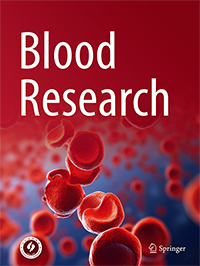Original Article
 Split Viewer
Split Viewer
Korean J Hematol 2012; 47(4):
Published online December 31, 2012
https://doi.org/10.5045/kjh.2012.47.4.286
© The Korean Society of Hematology
Serum hepcidin levels and iron parameters in children with iron deficiency
1Department of Pediatrics, Seoul National University Bundang Hospital, Seoul National University College of Medicine, Seongnam, Korea.
2Department of Laboratory Medicine, Seoul National University Hospital, Seoul National University College of Medicine, Seoul, Korea.
3Department of Pediatrics, Chosun University Hospital, Gwangju, Korea.
4Department of Laboratory Medicine & Genetics, Samsung Medical Center, Sungkyunkwan University School of Medicine, Seoul, Korea.
Correspondence to : Correspondence to Hye Ran Yang, M.D., Ph.D. Department of Pediatrics, Seoul National University Bundang Hospital, 82, Gumi-ro 173 Beon-gil, Bundang-gu, Seongnam 463-707, Korea. Tel: +82-31-787-7285, Fax: +82-31-787-4054, hryang@snubh.org
This is an Open Access article distributed under the terms of the Creative Commons Attribution Non-Commercial License (http://creativecommons.org/licenses/by-nc/3.0/) which permits unrestricted non-commercial use, distribution, and reproduction in any medium, provided the original work is properly cited.
Background
Iron deficiency (ID) and iron deficiency anemia (IDA) are common nutritional disorders in children. Hepcidin, a peptide hormone produced in the liver, is a central regulator of systemic iron metabolism. We evaluated whether serum hepcidin levels can diagnose ID in children.
Methods
Sera from 59 children (23 males and 36 females; 5 months to 17 years) were analyzed for hepcidin-25 by ELISA. Patients were classified according to hemoglobin level and iron parameters as: IDA, (N=17), ID (N=18), and control (N=24).
Results
Serum hepcidin, ferritin, soluble transferrin receptor (sTfR), transferrin saturation, and hemoglobin levels differed significantly between groups (
Conclusion
Serum hepcidin levels are significantly associated with iron status and can be a useful indicator of ID. Further studies are necessary to validate these findings and determine a reliable cutoff value in children.
Keywords Serum hepcidin, Iron deficiency, Children
Article
Original Article
Korean J Hematol 2012; 47(4): 286-292
Published online December 31, 2012 https://doi.org/10.5045/kjh.2012.47.4.286
Copyright © The Korean Society of Hematology.
Serum hepcidin levels and iron parameters in children with iron deficiency
Hyoung Soo Choi1, Sang Hoon Song2, Jae Hee Lee3, Hee-Jin Kim4, and Hye Ran Yang1*
1Department of Pediatrics, Seoul National University Bundang Hospital, Seoul National University College of Medicine, Seongnam, Korea.
2Department of Laboratory Medicine, Seoul National University Hospital, Seoul National University College of Medicine, Seoul, Korea.
3Department of Pediatrics, Chosun University Hospital, Gwangju, Korea.
4Department of Laboratory Medicine & Genetics, Samsung Medical Center, Sungkyunkwan University School of Medicine, Seoul, Korea.
Correspondence to: Correspondence to Hye Ran Yang, M.D., Ph.D. Department of Pediatrics, Seoul National University Bundang Hospital, 82, Gumi-ro 173 Beon-gil, Bundang-gu, Seongnam 463-707, Korea. Tel: +82-31-787-7285, Fax: +82-31-787-4054, hryang@snubh.org
This is an Open Access article distributed under the terms of the Creative Commons Attribution Non-Commercial License (http://creativecommons.org/licenses/by-nc/3.0/) which permits unrestricted non-commercial use, distribution, and reproduction in any medium, provided the original work is properly cited.
Abstract
Background
Iron deficiency (ID) and iron deficiency anemia (IDA) are common nutritional disorders in children. Hepcidin, a peptide hormone produced in the liver, is a central regulator of systemic iron metabolism. We evaluated whether serum hepcidin levels can diagnose ID in children.
Methods
Sera from 59 children (23 males and 36 females; 5 months to 17 years) were analyzed for hepcidin-25 by ELISA. Patients were classified according to hemoglobin level and iron parameters as: IDA, (N=17), ID (N=18), and control (N=24).
Results
Serum hepcidin, ferritin, soluble transferrin receptor (sTfR), transferrin saturation, and hemoglobin levels differed significantly between groups (
Conclusion
Serum hepcidin levels are significantly associated with iron status and can be a useful indicator of ID. Further studies are necessary to validate these findings and determine a reliable cutoff value in children.
Keywords: Serum hepcidin, Iron deficiency, Children
Fig 1.

Receiver operating characteristic curves for serum hepcidin and serum ferritin.
Fig 2.

Distribution of serum hepcidin levels in the IDA, ID, and normal controls around the cutoff point. IDA, iron deficiency anemia; ID, iron deficiency.
Fig 3.

Correlations between serum hepcidin and other parameters. Common regression lines are shown.
-
Table 1 . Subject characteristics..
Time of sampling (1/2/3): 1, before midday; 2, midday to 5 pm; 3, after 5 pm..
Abbreviations: BMI, body mass index; sTfR, soluble transferrin receptor; TIBC, total iron binding capacity; Hb, hemoglobin; CRP, C-reactive protein;
H. pylori ,Helicobacter pylori ..
-
Table 2 . Correlations between log hepcidin and other parameters..
Abbreviations: BMI, body mass index; sTfR, soluble transferrin receptor; TIBC, total iron binding capacity; Hb, hemoglobin; CRP, C-reactive protein;
H. pylori ,Helicobacter pylori ..
-
Table 3 . Adjusteda) simple linear regression for log hepcidin..
a)Adjusted for age, gender, and body mass index..
Abbreviations: sTfR, soluble transferrin receptor; TIBC, total iron binding capacity; Hb, hemoglobin; CRP, C-reactive protein; CI, confidence interval; SE, standard error..

Article Tools
Stats or Metrics
Related articles in BR
-
Prognostic impact of total body irradiation dose in pediatric acute lymphoblastic leukemia patients treated with allogeneic hematopoietic stem cell transplantation in second complete remission
Wonjin Jang, Suejung Jo, Jae Won Yoo, Seongkoo Kim, Jae Wook Lee, Pil-Sang Jang, Nack-Gyun Chung, Bin Cho
Blood Res 2022; 57(4): 256-263 -
Clinical characteristics and treatment outcomes of children and adolescents with aggressive mature B-cell lymphoma: a single-center analysis
Woojung Jeon, Young Kwon Koh, Sunghan Kang, Hyery Kim, Kyung-Nam Koh, Ho Joon Im
Blood Res 2022; 57(1): 41-50 -
Biphenotypic acute leukemia or acute leukemia of ambiguous lineage in childhood: clinical characteristics and outcome
Hyun Gyung Lee, Hee Jo Baek, Ho Sung Kim, Soo Min Park, Tai Ju Hwang, and Hoon Kook
Blood Res 2019; 54(1): 63-73




 PDF
PDF Standard view
Standard view Export citation
Export citation Share
Share  Download
Download Previous Article
Previous Article



